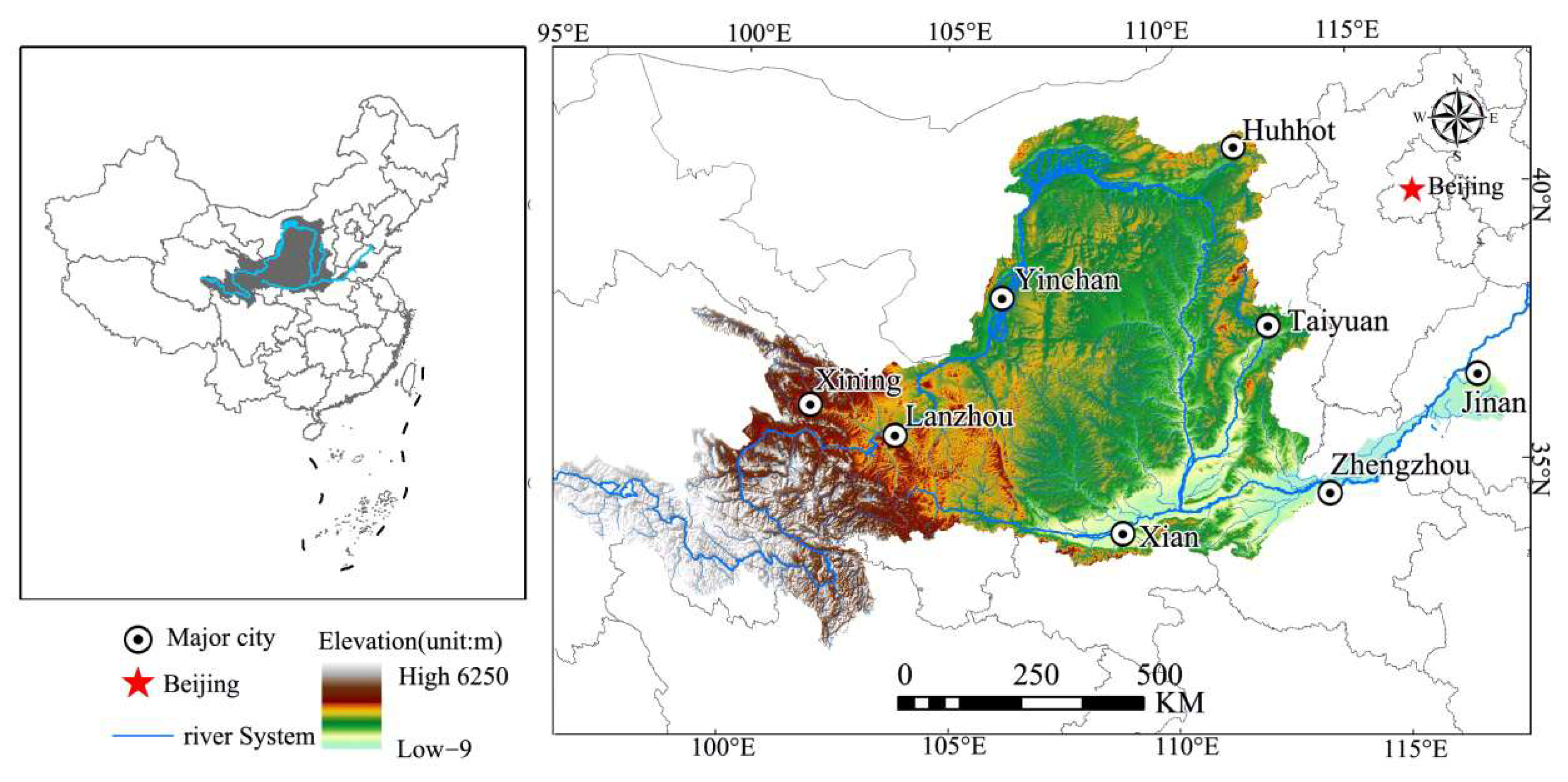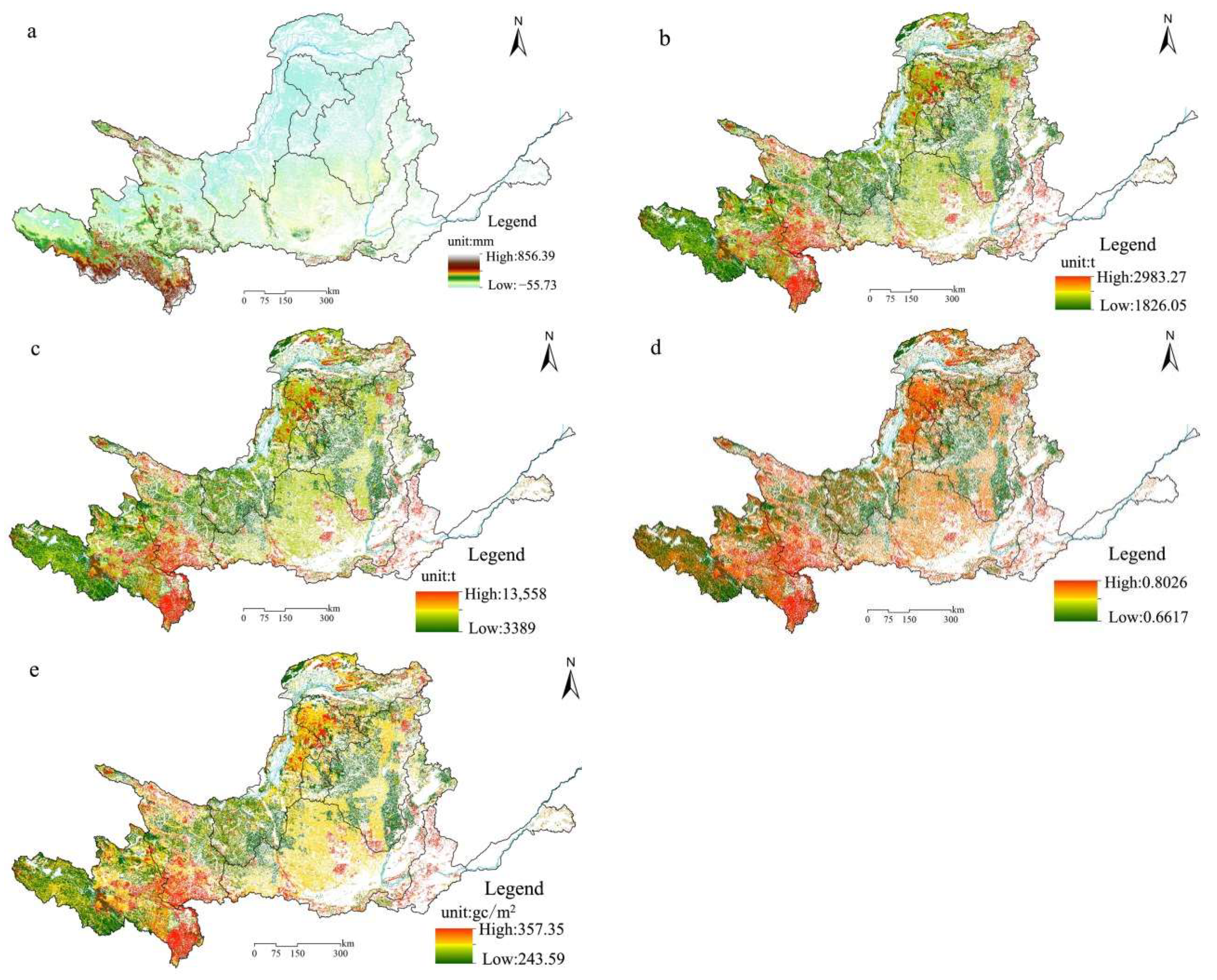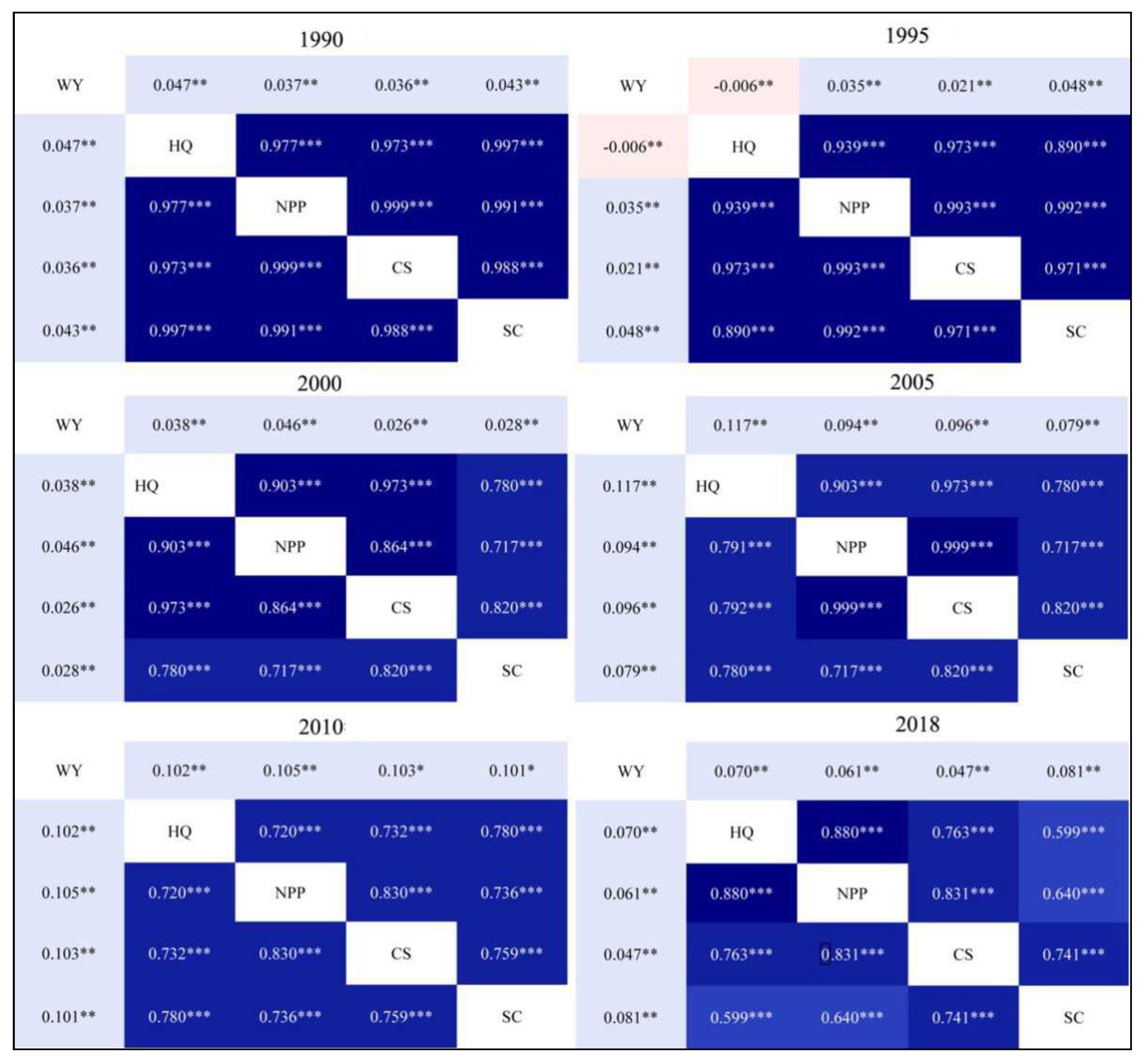The Trade-Offs and Synergistic Relationships between Grassland Ecosystem Functions in the Yellow River Basin
Abstract
:1. Introduction
2. Study Area
3. Data and Methodology
3.1. Data Sources
3.2. Method
3.2.1. Water Yield
3.2.2. Soil Conservation
3.2.3. Carbon Storage
3.2.4. Habitat Quality
3.2.5. NPP
3.2.6. The Trade-Off and Synergy Analysis
3.2.7. Global Spatial Autocorrelation
4. Results and Analysis
4.1. Temporal and Spatial Characteristics of Grassland Ecosystem Services
4.2. Changes in Trade-Offs and Synergistic Relationships between Grassland Ecosystem Functions from 1990 to 2018
4.3. Spatial Expression of Trade-Offs and Synergistic Relationships between Grassland Ecosystem Functiond
5. Discussion
6. Conclusions
Author Contributions
Funding
Institutional Review Board Statement
Informed Consent Statement
Data Availability Statement
Conflicts of Interest
References
- Han, D.; Wang, G.; Xue, B.; Liu, T.; Yinglan, A.; Xu, X. Evaluation of semiarid grassland degradation in North China from multiple perspectives. Ecol. Eng. 2018, 112, 41–50. [Google Scholar] [CrossRef]
- Peciña, M.V.; Ward, R.D.; Bunce, R.G.H.; Sepp, K.; Kuusemets, V.; Luuk, O. Country-scale mapping of ecosystem services provided by semi-natural grasslands. Sci. Total. Environ. 2019, 661, 212–225. [Google Scholar] [CrossRef] [PubMed]
- Wang, Z.; Deng, X.; Song, W.; Li, Z.; Chen, J. What is the main cause of grassland degradation? A case study of grassland ecosystem service in the middle-south inner mongolia. Catena 2017, 150, 100–107. [Google Scholar] [CrossRef]
- Yang, S.; Hao, Q.; Liu, H.; Zhang, X.; Yu, C.; Yang, X.; Xia, S.; Yang, W.; Li, J.; Song, Z. Impact of grassland degradation on the distribution and bioavailability of soil silicon: Implications for the si cycle in grasslands. Sci. Total Environ. 2019, 657, 811–818. [Google Scholar] [CrossRef] [PubMed]
- Bai, Y.F.; Huang, J.H.; Zheng, S.X.; Pan, Q.M.; Zhang, L.X.; Zhou, H.K.; Liang, X.; Lin, L.Y.; Jian, M. Drivers and regulating mechanisms of grassland and desert ecosystem services. Chin. J. Plant Ecol. 2014, 38, 93–102. [Google Scholar]
- Peng, J.; Hu, X.X.; Zhao, M.Y.; Liu, Y.X.; Tian, L. Research progress on ecosystem service trade-offs: From cognition to decision-making. Acta Geogr. Sin. 2017, 72, 960–973. [Google Scholar]
- Tang, Y.K.; Wu, Y.T.; Wu, K.; Guo, Z.W.; Liang, C.-Z.; Wang, M.-J.; Chang, P.-J. Changes in trade-offs of grassland ecosystem services and functions under different grazing intensities. Chin. J. Plant Ecol. 2019, 43, 408–417. [Google Scholar] [CrossRef]
- Lu, Y.H.; Fu, B.J.; Feng, X.M.; Zeng, Y.; Liu, Y.; Chang, R.; Sun, G.; Wu, B. A policy-driven large scale ecological restoration: Quantifying ecosystem services changes in the Loess Plateau of China. PLoS ONE 2012, 7, 10. [Google Scholar]
- Wu, D.; Shao, Q.Q.; Liu, J.Y.; Cao, W. Spatiotemporal dynamics of water regulation service of grassland ecosystem in China. Res. Soil Water Conserv. 2016, 23, 256–260. [Google Scholar]
- Liu, H.J.; Gao, J.X. Measurement and dynamic change of ecosystem services value in the farming-pastoral ecotone of northern China. J. Mt. Sci. 2008, 26, 145–153. [Google Scholar]
- Zhang, X.F.; Niu, J.M.; Zhang, Q.; Dong, J.J.; Zhang, J. Spatial pattern of water conservation function in grassland ecosystem in the Xilin river basin, Inner Mongolia. Arid. Zone Res. 2016, 33, 814–821. [Google Scholar]
- Zhong, J.T.; Wang, B.; Mi, W.B.; Fan, X.G.; Yang, M.L.; Yang, X.M. Spatial recognition of ecological compensation standard for grazing grassland in Yanchi county based on InVEST model. Sci. Geogr. Sin. 2020, 40, 1019–1028. [Google Scholar]
- LuZeng, Z.Z.; Huang, X.X.; Sun, X.N.; Wang, X.Y.; He, K.J.; Zhang, Y. Effects of disturbance on landscape pattern and meadow ecosystem services, in the Yak Park of Mt. Jade Dragon, Yunnan. Ecol. Environ. Sci. 2020, 29, 725–732. [Google Scholar]
- Byrd, K.B.; Flint, L.E.; Alvarez, P.; Sleeter, B.M.; Sohl, T. Integrated climate and land use change scenarios for California rangeland ecosystem services: Wildlife habitat, soil carbon, and water supply. Landsc. Ecol. 2015, 30, 729–750. [Google Scholar] [CrossRef] [Green Version]
- Du, Y.G.; Ke, X.; Guo, X.W.; Cao, G.; Zhou, H. Soil and plant community characteristics under long-term continuous grazing of different intensities in an alpine meadow on the Tibetan plateau. Biochem. Syst. Ecol. 2019, 85, 72–75. [Google Scholar] [CrossRef]
- Pan, T.; Hou, S.; Liu, Y.; Tan, Q.; Gao, X. Influence of degradation on soil water availability in an alpine swamp meadow on the eastern edge of the Tibetan Plateau. Sci. Total. Environ. 2020, 722, 137677. [Google Scholar] [CrossRef]
- Zhang, W.J.; Xue, X.; Peng, F.; You, Q.G.; Hao, A.H. Meta-analysis of the effects of grassland degradation on plant and soil properties in the alpine meadows of the Qinghai-Tibetan Plateau. Glob. Ecol. Conserv. 2019, 20, e00774. [Google Scholar] [CrossRef]
- Mouchet, M.A.; Lamarque, P.; Martín-López, B.; Crouzat, E.; Gos, P.; Byczek, C.; Lavorel, S. An interdisciplinary methodological guide for quantifying associations between ecosystem services. Glob. Environ. Chang. 2014, 28, 298–308. [Google Scholar] [CrossRef]
- Deng, X.; Li, Z.; Gibson, J. A review on trade-off analysis of ecosystem services for sustainable land-use management. J. Geogr. Sci. 2016, 26, 953–968. [Google Scholar] [CrossRef] [Green Version]
- Kragt, M.E.; Robertson, M.J. Quantifying ecosystem services trade-offs from agricultural practices. Ecol. Econ. 2014, 102, 147–157. [Google Scholar] [CrossRef]
- Su, C.H.; Fu, B.J.; Wei, Y.P.; Lu, Y.H.; Liu, G.H.; Wang, D.L.; Mao, K.; Feng, X. Ecosystem management based on ecosystem services and human activities: A case study in the Yanhe watershed. Sustain. Sci. 2012, 7, 17–32. [Google Scholar] [CrossRef]
- Haase, D.; Schwarz, N.; Strohbach, M.; Kroll, M.; Seppelt, R. Synergies, trade-offs, and losses of ecosystem services in urban regions: An integrated multiscale framework applied to the Leipzig-Halle Region, Germany. Ecol. Soc. 2012, 17, 22. [Google Scholar] [CrossRef]
- Thompson, J.R.; Lambert, K.F.; Foster, D.R.; Broadbent, E.N.; Blumstein, M.; Zambrano, A.M.A.; Fan, Y. The consequences of four land-use scenarios for forest ecosystems and the services they provide. Ecosphere 2016, 7, e01469. [Google Scholar] [CrossRef] [Green Version]
- Rao, S.; Lin, Q.; Wang, X.H.; Zhang, H.Y.; Lu, Y. The trade-off between ecosystem services in Zhenglan Banner. J. Arid. Land Resour. Environ. 2015, 29, 81–86. [Google Scholar]
- Li, J.; Li, H.Y.; Zhang, L. Ecosystem service trade-offs in the Guanzhong-Tianshui economic region of China. Acta Ecol. Sin. 2016, 36, 3053–3062. [Google Scholar]
- Yang, X.N.; Li, J.; Qin, K.Y.; Li, T.; Liu, J.Y. Trade-offs between ecosystem services in Guanzhong-Tianshui economic region. Acta Geogr. Sin. 2015, 70, 1762–1773. [Google Scholar]
- Xu, H.; Shi, N.; Wu, L.L.; Zhang, D.W. High-quality development level and its spatiotemporal changes in the Yellow River Basin. Resour. Sci. 2020, 42, 115–126. [Google Scholar] [CrossRef]
- Chen, W.Y.; Zheng, H.P.; Qi, D.C.; Li, G.Y.; Liu, Z.H. Species diversity changes in converse successions of grassland in important eco-function area in the upper reaches of the Yellow River. Chin. J. Grassl. 2007, 29, 6–11. [Google Scholar]
- Zheng, Q.Z.; Xu, X.Y.; Liu, X.P.; Tang, J.N.; Chai, C.W. Classification and control of grassland desertification in Maqu of the upper Yellow River. Technol. Soil Water Conserv. 2012, 5, 1–4. [Google Scholar]
- Zhou, W.; Gang, C.C.; Li, J.L.; Zhang, C.B.; Mu, S.J. Spatial-temporal dynamics of grassland coverage and its response to climate change in China during 1982–2010. Acta Geogr. Sin. 2014, 69, 15–30. [Google Scholar]
- Yang, X.; Xiao, Q.; Ouyang, Z.; Qin, M. Assessing changes in water flow regulation in Chongqing region, China. Environ. Monit. Assess. 2015, 187, 362. [Google Scholar]
- Wischmeier, W.H.; Smith, D.D. Predicting Rainfall Erosion Losses-A Guide to Conservation Planning; USDA Agricultural Handbook No 537; USDA: Washington, DC, USA, 1978.
- Bao, Y.B.; Liu, K.; Li, T.; Hu, S. Effects of land use change on habitat based on InVEST Model—Taking Yellow River wetland nature reserve in Shaanxi Province as an example. Arid Zone Res. 2015, 32, 622–629. [Google Scholar]
- Zhu, W.Q.; Pan, Y.Z.; Long, Z.H.; Chen, Y.H.; Li, J. Estimating net primary productivity of terrestrial vegetation based on GIS and RS: A case study in Inner Mongolia, China. J. Remote. Sens. 2005, 9, 300–307. [Google Scholar]
- Coops, N.; Waring, R. The use of multiscale remote sensing imagery to derive regional estimates of forest growth capacity using 3-PGS. Remote. Sens. Environ. 2001, 75, 324–334. [Google Scholar] [CrossRef]
- Zhu, W.Q.; Pan, Y.Z.; Zhang, J.S. Estimation of net primary productiovity of Chinese terrestrial vegetation based on remote sensing. J. Plant Ecol. 2007, 31, 413–424. [Google Scholar]
- Vallet, A.; Locatelli, B.; Levrel, H.; Wunder, S.; Seppelt, R.; Scholes, R.J.; Oszwald, J. Relationships between ecosystem services: Comparing methods for assessing tradeoffs and synergies. Ecol. Econ. 2018, 150, 96–106. [Google Scholar] [CrossRef]
- Yang, J.; Xie, B.P.; Tao, W.Q. Ecosystem Services Assessment, Trade-Off and Bundles in the Yellow River Basin, China. Diversity 2021, 13, 308. [Google Scholar] [CrossRef]
- Huang, J.T.; Cao, Y.P.; Qin, F. Analysis of eco-environment quality based on Land Use/Cover Change in the Yellow River Basin. J. Henan Univ. Nat. Sci. 2020, 44, 127–138. [Google Scholar]
- Dai, L.W.; Tang, H.P.; Zhang, Q.; Cui, F.Q. The trade-off and synergistic relationship among ecosystem services: A case study in Duolun County, the agro-pastoral ecotone of northern China. Acta Ecol. Sin. 2020, 40, 2863–2876. [Google Scholar]
- Chen, X.M.; Wang, X.F.; Feng, X.M.; Zhang, X.R.; Luo, G.X. Ecosystem service trade-off and synergy on Qinghai-Tibet Plateau. Geogr. Res. 2021, 40, 18–34. [Google Scholar]
- Zhou, Z.X.; Li, J.; Guo, Z.Z.; Li, T. Trade-offs between carbon, water, soil and food in Guanzhong-Tianshui economic region from remotely sensed data. Int. J. Appl. Earth Obs. Geoinf. 2017, 58, 145–156. [Google Scholar] [CrossRef]
- Qian, D.; Du, Y.; Li, Q.; Guo, X.; Cao, G. Alpine grassland management based on ecosystem service relationships on the southern slopes of the Qilian Mountains, China. J. Environ. Manag. 2021, 288, 112447. [Google Scholar] [CrossRef] [PubMed]
- Li, S.C.; Zhang, C.Y.; Liu, J.L.; Zhu, W.B.; Ma, C. The tradeoffs and synergies of ecosystem services: Research progress, development trend, and themes of geography. Geogr. Res. 2013, 32, 1379–1390. [Google Scholar]
- Gong, J.; Liu, D.Q.; Gao, B.L.; Xu, C.X.; Li, Y. Trade-offs and synergies of ecosystem services in western mountainous China: A case study of the Bailongjiang watershed in Gansu, China. Chin. J. Appl. Ecol. 2020, 31, 1278–1288. [Google Scholar]





| Year | Water Yield Depth (mm) | Soil Conservation (108 t) | Carbon Storage (108 t) | Habitat Quality | NPP (gc·m−2) |
|---|---|---|---|---|---|
| 1990 | 42.19 | 9.201 | 26.653 | 0.686 | 204.66 |
| 1995 | 40.62 | 9.098 | 26.176 | 0.688 | 190.63 |
| 2000 | 23.28 | 8.792 | 24.858 | 0.686 | 225.76 |
| 2005 | 69.48 | 8.497 | 25.789 | 0.686 | 229.73 |
| 2010 | 44.40 | 8.201 | 25.351 | 0.686 | 255.91 |
| 2018 | 64.88 | 7.648 | 26.743 | 0.685 | 296.16 |
Publisher’s Note: MDPI stays neutral with regard to jurisdictional claims in published maps and institutional affiliations. |
© 2021 by the authors. Licensee MDPI, Basel, Switzerland. This article is an open access article distributed under the terms and conditions of the Creative Commons Attribution (CC BY) license (https://creativecommons.org/licenses/by/4.0/).
Share and Cite
Yang, J.; Xie, B.; Zhang, D. The Trade-Offs and Synergistic Relationships between Grassland Ecosystem Functions in the Yellow River Basin. Diversity 2021, 13, 505. https://doi.org/10.3390/d13100505
Yang J, Xie B, Zhang D. The Trade-Offs and Synergistic Relationships between Grassland Ecosystem Functions in the Yellow River Basin. Diversity. 2021; 13(10):505. https://doi.org/10.3390/d13100505
Chicago/Turabian StyleYang, Jie, Baopeng Xie, and Degang Zhang. 2021. "The Trade-Offs and Synergistic Relationships between Grassland Ecosystem Functions in the Yellow River Basin" Diversity 13, no. 10: 505. https://doi.org/10.3390/d13100505
APA StyleYang, J., Xie, B., & Zhang, D. (2021). The Trade-Offs and Synergistic Relationships between Grassland Ecosystem Functions in the Yellow River Basin. Diversity, 13(10), 505. https://doi.org/10.3390/d13100505





